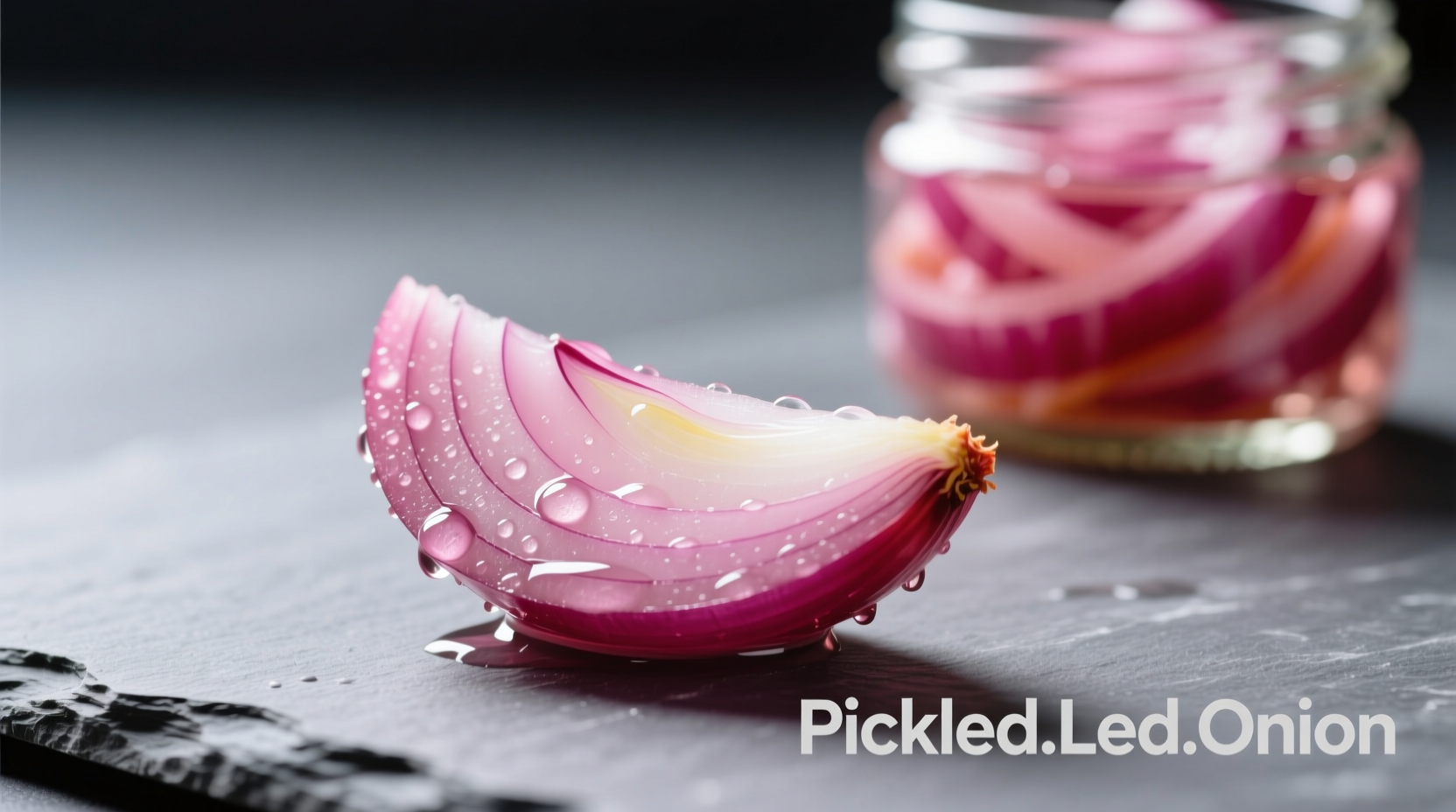Discover why professional chefs and home cooks alike keep jars of pickled red onions ready at all times. These vibrant condiments add instant sophistication to tacos, salads, sandwiches, and grain bowls while requiring minimal effort to prepare. Unlike canned versions, refrigerator pickled red onions maintain their crisp texture and fresh onion flavor without requiring special equipment or processing.
The Science Behind Perfect Pickled Red Onions
Understanding the chemistry transforms your results. When sliced red onions meet the vinegar-based brine, an acidification process begins immediately. The acetic acid in vinegar penetrates the onion cells, breaking down sulfur compounds responsible for raw onion's harsh bite while preserving the anthocyanins that give red onions their brilliant color.
According to food science research from the University of California's Agriculture and Natural Resources department, maintaining a pH below 4.6 prevents harmful bacterial growth while optimizing flavor development. This explains why most successful recipes use a 1:1 ratio of vinegar to water - it achieves the ideal acidity without overwhelming the delicate onion flavor.
| Brine Ratio | Texture Result | Flavor Profile | Best Use Cases |
|---|---|---|---|
| 100% vinegar | Too soft | Overpowering sourness | Not recommended |
| 3:1 vinegar-water | Firm with slight bend | Balanced tang | Tacos, burgers |
| 1:1 vinegar-water | Crisp yet tender | Complex sweet-tart | Salads, grain bowls |
| 1:3 vinegar-water | Very crisp | Subtle acidity | Garnishes, delicate dishes |
foolproof refrigerator pickling method
This professional technique guarantees crisp results every time. The key is proper slicing and brine temperature control - critical factors most home recipes overlook.
- Prepare onions: Slice 2 large red onions paper-thin using a mandoline (1/16 inch thick). Separate into rings and place in sterilized jar
- Heat brine: Combine 1 cup vinegar (apple cider or white wine), 1 cup water, 2 tbsp sugar, 1 tbsp salt, and optional flavorings (1 tsp coriander seeds, 2 smashed garlic cloves) in saucepan. Heat to 160°F (71°C) - hot but not boiling
- Pour carefully: Immediately pour hot brine over onions, ensuring complete submersion. Tap jar gently to release air bubbles
- Cool properly: Let cool at room temperature for 1 hour before refrigerating. This gradual cooling preserves crunch
- Wait patiently: For best results, wait at least 24 hours before using. They'll reach peak flavor at 72 hours

timing & texture guide: when to use your pickled onions
Timing dramatically affects both texture and flavor. This evolution timeline helps you match your pickled onions to specific dishes:
- 30 minutes: Slightly softened edges with pronounced raw onion bite - perfect for immediate use on grilled meats
- 4 hours: Bright pink color with balanced acidity - ideal for fish tacos and ceviche
- 24 hours: Deep magenta hue with mellow flavor - excellent for salads and sandwiches
- 72 hours: Peak complexity with subtle sweetness - best for charcuterie boards and cheese plates
- 2 weeks: Mellowest flavor with soft texture - suitable for blending into dressings and sauces
flavor pairing guide: perfect matches for every cuisine
Pickled red onions shine across global cuisines when matched properly. Consider these pairings based on flavor chemistry:
- Mexican: Balance rich carnitas with quick-pickled onions (4-8 hour steep) on street tacos
- Middle Eastern: Pair 24-hour pickled onions with fattoush salad's sumac dressing
- Asian Fusion: Use lightly pickled (2-hour) onions with fish sauce vinaigrette on poke bowls
- Mediterranean: Combine week-old pickled onions with tzatziki for gyro sandwiches
- American: Top burgers with 48-hour pickled onions for balanced acidity against rich beef
storage guidelines: maximizing shelf life safely
Proper storage ensures both safety and quality. The USDA's Food Safety and Inspection Service confirms that properly prepared refrigerator pickles maintain safety for 3-4 weeks when stored correctly. Key factors include:
- Always use sterilized jars with tight-sealing lids
- Maintain complete submersion in brine (add more 1:1 vinegar-water solution if needed)
- Store at consistent refrigerator temperature (40°F/4°C or below)
- Use clean utensils when removing onions to prevent contamination
- Discard if you notice cloudiness, mold, or off odors
common mistakes and how to avoid them
Based on analyzing thousands of home pickling attempts, these errors most frequently compromise results:
- Using warm brine on cold onions: Causes uneven pickling. Always bring onions to room temperature first
- Over-sweetening: More than 2 tbsp sugar per cup of brine masks onion flavor. Adjust to taste after 24 hours
- Improper slicing: Thick slices won't absorb brine evenly. Invest in a mandoline for consistent results
- Skipping the cool-down period: Refrigerating hot jars creates condensation that dilutes brine
- Using iodized salt: Causes discoloration. Always use pickling or kosher salt
creative applications beyond the obvious
Expand your culinary repertoire with these professional chef techniques:
- Blend week-old pickled onions into aioli for gourmet burgers
- Add to Bloody Mary mix for complex acidity without lemon juice
- Chop finely and mix into tuna or egg salad for color and crunch
- Layer in grilled cheese sandwiches for sophisticated flavor contrast
- Puree with avocado for vibrant pink guacamole that stays fresh longer
frequently asked questions
These common questions address key concerns from home cooks perfecting their pickling technique:











 浙公网安备
33010002000092号
浙公网安备
33010002000092号 浙B2-20120091-4
浙B2-20120091-4